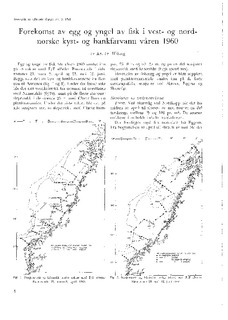| dc.description.abstract | In 1960 cod eggs and larvae were more abundant
at Skrova in the Lofoten area than in the previous
year (Table 1). Maxima of spawning and hatching
occurred 14 days earlier than in 1959. On the
western side of the Lofoten islands, at Eggum, cod
eggs and larvae were scarce in 1960.
On 31. March and 1. April cod eggs and larvae
were numerous in the inner part of the Lofoten
area (Fig. 3).
The Nansen net and the Clarke-Bumpus plankton
sampler have proved to be equally effective in
catching eggs and newly hatched larvae of the cod
(Table 2).
In March-April 196O eggs of cod were found in
smaller numbers over larger areas of the west coast
with moderate concentrations at the Møre and
Halten banks (Fig. 3).
Haddock eggs were scarce along the slope from
Træna to Andenes.
In April eggs of saithe and Norway pout occurred
in moderate numbers in the Vestfjord, but major
concentrations were only met with farther south,
from the Halten bank to Stad (Fig. 4).
In March-April 1960 herring larvae were found
in the coastal area from south of Bergen to Andenes,
with major concentrations on the Møre-, Frøya-,
Sklinna- and Halten-banks, in the order mentioned,
mean numbers per m^2 of sea surface 630-230
(Fig.s 5, 6).
The statement by various workers that herring
larvae are caught to a greater extent by night than
by day in traditional nets, was confirmed. A comparison
between the catches in hauls with Nansen
net and Clarke-Bumpus plankton sampler (Table 3)
showed that during the night the two gears caught
nearly the same number of herring larvae, 8-13
mm in length, per m^2 of sea surface (Table 3).
When all hauls were included, the Nansen net
took more than ten times as many, Clarke-Bumpus
sampler nearly twice as many herring larvae during
the night, as during the day.
If three night hauls with high numbers of larvae
were excluded from the mean, the night to day
ratio for the Nansen net was 4.5/1, for the Clarke-Bumpus
sampler 1.3/1. It is therefore assumed that
the Clarke-Bumpus sampler is more effective than
the Nansen net in catching herring larvae of the
size mentioned, and may be used with a certain
degree of reliability also during the day.
In the middle of May larvae of capelin were
abundant near Northcape (Table 4). Redfish larvae
were numerous along the coast in May-June (Fig. 7). | en_US |
